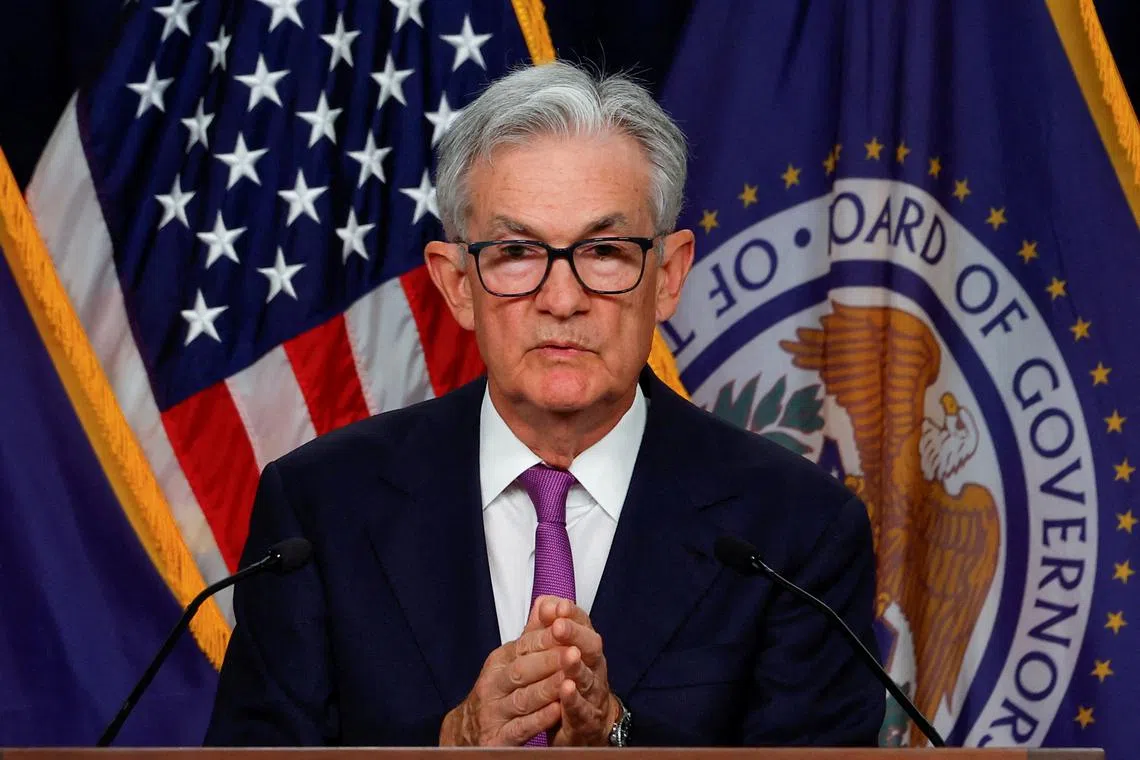Asia markets falter, US dollar rallies as Fed signals no rush to cut interest rates
Sign up now: Get ST's newsletters delivered to your inbox

US Federal Reserve Chairman Jerome Powell said the Fed was also cognisant of the need to prevent tripping up the US economy.
PHOTO: REUTERS
Follow topic:
SINGAPORE – While the Federal Reserve kept its benchmark interest rate unchange
Stocks in Asia slid on Thursday and United States markets fell overnight, while the US dollar strengthened after the Fed signalled interest rates will be higher for longer.
Japan’s Nikkei 225 fell 1.37 per cent, while Hong Kong’s Hang Seng Index lost 1.3 per cent and the Shanghai Composite dipped 0.8 per cent.
South Korea’s Kospi index tumbled 1.75 per cent, while Australia’s S&P/ASX 200 dropped 1.4 per cent.
In Singapore, the Straits Times Index closed down 1.2 per cent.
Overnight, the Dow Jones Industrial slipped 0.2 per cent, while the S&P 500 slid 0.9 per cent and the tech-heavy Nasdaq fell 1.5 per cent following the Fed announcement.
The US dollar rallied against major currencies and rose 0.2 per cent to 1.3680 to the Singapore dollar.
Following 11 rate hikes since the beginning of 2022, the Federal Open Market Committee (FOMC) held the Fed funds rate at between 5.25 per cent and 5.5 per cent at its Wednesday meeting.
The Fed also hinted that it could hike its key lending rate in November if necessary. There were no clear indications if the Fed would cut rates any time in 2024 either.
In short, rates will remain high for longer.
OCBC Bank’s chief economist Selena Ling described the latest Fed decision as a classic hawkish pause.
“We saw 12 out of 19 members of the Fed signalling one more hike to go ‘if appropriate’, and much less easing in 2024 than what market players had hoped for given a projected soft landing for the US economy,” she said.
“The knee-jerk risk-off sentiment saw the S&P 500 go lower and US Treasury yields go higher. Asian markets are likely to react similarly in a defensive manner today as investors brace (themselves) for a higher-for-longer US interest rate environment.”
The Fed’s hold on rates comes as US inflation has trended downwards since June, with the consumer price index rising by just over 3 per cent in the past two months, in contrast to 9 per cent at its peak a year ago.
“We want to see that the good inflation data we’ve received for the three months is more than just three months,” Fed chairman Jerome Powell said in remarks on Wednesday.
The biggest concern now appears to be stubbornly high energy prices.
The problem for financial markets and ordinary folk is the lagged effect of high-for-longer rates.
Ultimately, higher interest rates will hit corporate earnings of companies with high borrowings.
Households and consumers could also be impacted, especially those with big housing loans.
But Mr Powell also indicated that amid the tightening of policy to rein in inflation, the Fed was also cognisant of the need not to trip up the US economy at a time when political infighting portends a government shutdown, while American auto workers strike.
Mr Stephen Innes, managing partner at SPI Asset Management, reckons the critical question is where interest rates will ultimately settle once the Fed concludes its hiking cycle.
He noted that whether the US economy avoids a recession is a significant consideration for both stock and bond investors.
“However, based on their projections of sharply higher GDP (gross domestic product) growth, a lower unemployment rate and lower core inflation, the Fed is more self-assured that it can achieve a soft landing and that the economy can sustain higher rates for a longer period.
“Even if the Fed doesn’t hike, they will be in no rush to cut rates,” he wrote.
Mr Powell reiterated that he thought there is a plausible path for a “soft landing”, but declined to call his baseline expectation and “handicap” its likelihood.
“We’ve been seeing progress (in bringing down inflation) without higher unemployment,” he said.
Still, economists and market experts generally saw a more confident Fed, which rates the US economy as doing reasonably well despite the tightest monetary stance in almost four decades.
Mr Alvin Liew, senior economist at UOB, noted that the most consequential release of the September FOMC meeting is the “dotplot” which indicated strong but not unanimous support among policy members for one more hike in 2023.
“The implication is very clear, that expectations for rate cuts in 2024 have been drastically curbed, and Fed policy could remain tight for a much longer duration than what we previously believed,” he noted.
“We also expect the Fed rate cuts to be delayed till mid-2024 (from the previous forecast of first quarter 2024) and at a less aggressive pace of just 75 basis points (bps) of rate cuts for 2024 (from the previous forecast of a 125bps cut).”
Goldman Sachs economists pushed back their forecast for the Fed to begin cutting rates to the fourth quarter of 2024, later than an earlier prediction of a second-quarter cut.


